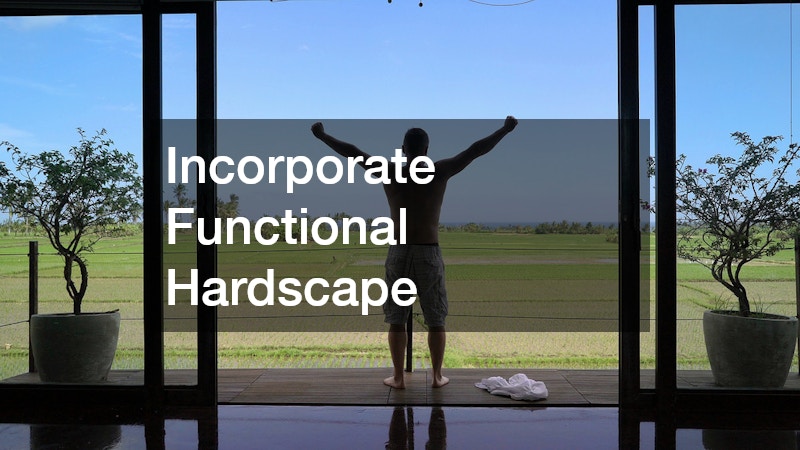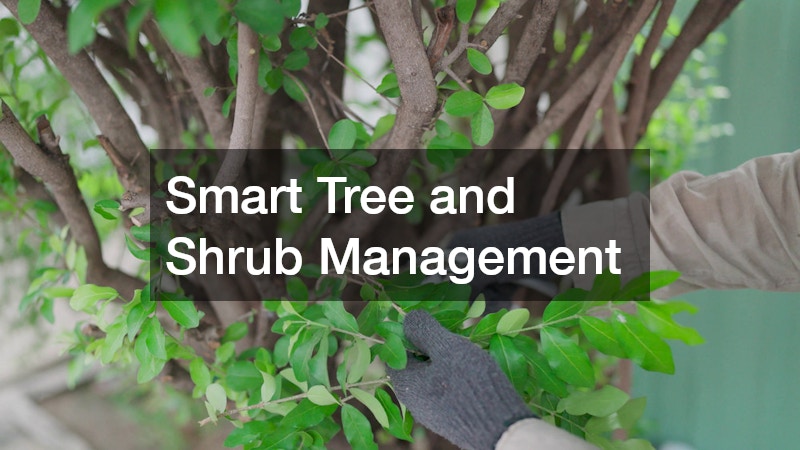A beautiful yard doesn’t have to be a full-time job. Many homeowners dream of an outdoor space that impresses guests, feels inviting, and boosts curb appeal—but the reality often involves hours spent mowing, pruning, watering, and cleaning. Low-maintenance landscaping is about smart planning, thoughtful plant selection, and incorporating elements that require minimal ongoing effort.
A well-designed yard balances aesthetics with functionality, ensuring that each feature contributes to the overall appeal while keeping upkeep manageable. With the right strategies, you can enjoy a lush lawn, vibrant garden beds, and attractive hardscapes without the constant stress of labor-intensive maintenance. This guide explores practical ways to create a yard that wows, offering advice that spans plant selection, hardscaping, water features, tree management, and seasonal care.
By the end, you’ll have the tools to plan a yard that thrives on its own while allowing you to enjoy it rather than constantly working in it.
Plan Your Layout Strategically
The foundation of a low-maintenance yard is thoughtful planning. Without a clear layout, plants may be overcrowded, pathways might erode quickly, and some areas could become inaccessible. Effective planning reduces unnecessary work, prevents frustration, and ensures your yard looks cohesive.
Start by dividing your yard into functional zones. Patios or seating areas provide spaces for entertaining, while garden beds and lawns serve as aesthetic focal points. Even small yards benefit from separating functional areas to prevent overlap between foot traffic and planting zones.
Using durable landscaping materials helps minimize ongoing upkeep. Gravel, river rock, or mulch suppresses weeds, retains moisture, and reduces erosion. For example, placing mulch around trees or flower beds not only looks neat but also eliminates frequent weeding and watering. Large mulch beds along fences or borders create a clean appearance that remains attractive throughout the year.
Paths and walkways are another consideration. A paving company can create durable stone or brick pathways that withstand weather, foot traffic, and erosion. Properly paved surfaces are easier to clean, reduce muddy spots, and guide visitors through the yard, preventing damage to plant beds. Even small touches like stepping stones can make movement easier and reduce wear on the grass.
Irrigation is another crucial factor. Installing a drip irrigation system or timed sprinklers ensures plants receive consistent water with minimal effort. Grouping plants with similar water needs simplifies the watering process and prevents over- or under-watering. Sketching your yard, even roughly, can help visualize placement and plan for furniture, plant beds, and decorative elements, reducing costly mistakes in the long run.
Choose the Right Plants for Longevity
Plant selection is critical in a low-maintenance yard. Choosing plants suited to your climate and soil reduces watering, pruning, and pest control needs. Native plants and drought-tolerant varieties thrive naturally, requiring less care and fewer chemical inputs. Perennials, ornamental grasses, and slow-growing shrubs provide long-lasting beauty with minimal replacement.
Soil preparation is equally important. Topsoil delivery ensures that garden beds have nutrient-rich soil that promotes healthy root growth. Strong roots mean plants are more resilient, drought-resistant, and less susceptible to disease. Mixing compost into topsoil further improves nutrient content, drainage, and water retention, creating the ideal foundation for your garden.
Lawn maintenance is another area where smart choices pay off. Lawn care services can handle mowing, aeration, and fertilization, keeping grass lush while saving you time. Choosing drought-tolerant or slow-growing grass varieties reduces mowing frequency and water usage. Additionally, dividing lawns into zones for high-use versus low-use areas allows for selective care, minimizing unnecessary effort.
Grouping plants with similar light and water requirements simplifies care. For example, a sunny border can include lavender, ornamental grasses, and sedum, while shaded areas can feature ferns, hostas, and shade-loving perennials. Raised beds or planters can help contain plant growth, reduce weeding, and make watering more efficient.
Other tips include:
-
Use groundcover plants like creeping thyme or clover to reduce large grass areas.
-
Incorporate shrubs that maintain shape naturally to avoid frequent pruning.
-
Plan for seasonal interest by including spring bulbs, summer perennials, and fall foliage.
Creating a planting map that details bloom times, water requirements, and height helps manage maintenance and ensures your yard remains visually appealing throughout the year.
Incorporate Functional Hardscape
Hardscapes are a practical and aesthetic element of a low-maintenance yard. Decks, patios, retaining walls, and raised garden beds reduce the area that requires mowing or frequent care. Structures made from durable materials from a lumber service can last for decades, minimizing long-term upkeep.
Consulting a local roofer is wise when structures attach to your home or affect drainage. Poor installation can result in water damage, rot, or structural issues, which increase maintenance demands.
Hardscapes can also serve functional purposes beyond reducing lawn care. A stone patio or gravel terrace replaces portions of the lawn, while raised beds simplify planting and harvesting. Retaining walls create terraced garden areas that are easier to manage than steep slopes, and benches or integrated seating enhance usability without adding extra work.
Tips for functional hardscapes include:
-
Build raised garden beds for vegetables or perennials to reduce bending and weeding.
-
Use stone or brick paths to define walkways and reduce grass wear.
-
Install pergolas or trellises for low-maintenance climbing plants.
-
Choose weather-resistant finishes on wood or stone to extend longevity.
Well-planned hardscapes also help define visual zones, making your yard appear organized and intentional while requiring less effort to maintain over time.
Install Water Features With Minimal Effort
Water features can bring life and a sense of tranquility to a yard, but some require intensive upkeep. Low-maintenance options like pondless waterfalls, self-contained fountains, or birdbaths provide aesthetic appeal without daily labor.
For more extensive features, a local pool company can ensure installation is efficient and recommend filtration systems that minimize cleaning. Proper preparation with an excavating company ensures the area is level, drains correctly, and prevents future problems such as soil erosion or flooding.
Low-maintenance water features ideas:
-
Fountain bowls with recirculation pumps.
-
Small pondless waterfalls with hidden reservoirs.
-
Birdbaths or tiered fountains with simple filtration.
Surrounding water features with gravel or mulch helps control weeds and makes cleaning easier. Choosing durable pumps and self-cleaning systems ensures a long-lasting, beautiful feature that requires minimal attention. Water features also enhance the overall atmosphere of the yard, creating an inviting space without extra labor.
Smart Tree and Shrub Management
Trees and shrubs provide structure, shade, and visual interest, but they can be maintenance-heavy if not selected or managed carefully. Slow-growing species with minimal leaf drop are ideal for low-maintenance yards. Evergreen and ornamental trees often require less pruning and provide year-round appeal.
Sometimes, older or unhealthy trees need removal to maintain safety and reduce yard maintenance. A tree removal company can handle large or potentially hazardous trees safely. Strategically placed trees also provide shade for other plants, reducing watering needs and contributing to a more sustainable landscape.
Regular lawn care services complement tree and shrub management by maintaining grass around trees and preventing overgrowth. Annual pruning, mulching, and pest monitoring ensure healthy growth with minimal intervention. Shrubs can act as natural borders, minimizing weed growth along fences or pathways and reducing the need for frequent edging.
Additional tips:
-
Use native trees that are pest-resistant and adapted to your climate.
-
Place trees strategically to reduce water needs for other plants.
-
Prune lightly rather than heavily to maintain shape with less effort.
Mulching, Soil Care, and Weed Prevention
Mulching is one of the easiest ways to reduce maintenance while improving aesthetics. A thick layer suppresses weeds, retains soil moisture, and improves soil quality over time. Mulching around shrubs, trees, and flower beds significantly cuts down on manual labor.
Topsoil delivery ensures garden beds are nutrient-rich and plants grow healthy roots. Combining this with long-lasting landscaping materials such as gravel or bark in high-traffic areas further reduces maintenance. Gravel paths prevent soil erosion and define walking areas, while mulch borders keep weeds from spreading into plant beds.
Effective mulching strategies:
-
Organic mulch under trees and shrubs enriches the soil over time.
-
Gravel along paths reduces weeding and defines borders.
-
Refresh mulch once or twice per year for continued effectiveness.
-
Combine mulch and decorative rocks for a polished look.
Mulching also enhances aesthetics. Contrasting colors of mulch and rocks with plant foliage or hardscape elements create a visually appealing yard with minimal effort. This simple step reduces labor and makes the garden appear well-kept year-round.
Enhance Your Yard With Outdoor Lighting and Accessories
Lighting and thoughtful accessories can completely transform a low-maintenance yard into a space that looks curated and inviting at all times of day. Outdoor lighting not only enhances the visual appeal but also improves safety, security, and usability of the yard without adding significant upkeep.
Tips for low-maintenance outdoor lighting:
-
Solar lights: Solar-powered path lights or spotlights are easy to install and do not require wiring or electricity. They automatically charge during the day and turn on at night.
-
LED lighting: Energy-efficient LED lights last longer and require less frequent replacement than traditional bulbs. They can highlight trees, plants, or architectural elements in the yard.
-
Motion-sensor lights: Ideal for safety and security, motion-sensor lights only activate when needed, reducing electricity usage and maintenance.
-
String lights and lanterns: Outdoor string lights hung along fences, pergolas, or patios add ambiance and can be easily removed or replaced seasonally.
Accessories can also elevate the space without increasing labor:
-
Decorative planters: Using pots and containers allows for seasonal plant changes without disturbing permanent beds.
-
Outdoor rugs and furniture cushions: Choosing weather-resistant fabrics reduces cleaning and replacement needs.
-
Garden art or sculptures: Strategically placed decorative elements add interest and personality without extra effort.
Incorporating lighting and accessories strategically can make a yard feel finished and welcoming even after the sun goes down. Low-maintenance lighting solutions enhance the beauty of your plantings, hardscapes, and pathways without adding hours of work. Additionally, accessories like self-watering planters or decorative mulch boxes can provide visual appeal while contributing to low-maintenance goals.
Properly planned lighting and accessories encourage more use of outdoor spaces, making patios, decks, and garden areas comfortable for evening gatherings or quiet relaxation. By adding these final touches thoughtfully, your yard can be enjoyed day and night, increasing functionality while still being easy to maintain.
Seasonal Maintenance Simplified
Even low-maintenance yards need attention each season, but breaking tasks into manageable steps keeps the workload light. Lawn care services can handle mowing, fertilization, aeration, and weed control, maintaining a healthy lawn with minimal effort from the homeowner.
A paving company can inspect patios, walkways, and driveways seasonally to prevent small cracks or weed growth from turning into larger problems. Seasonal planning ensures that tasks are predictable, achievable, and not overwhelming.
Sample seasonal checklist:
-
Spring: Prune shrubs, plant annuals, check irrigation.
-
Summer: Water efficiently, control pests, and manage weeds.
-
Fall: Remove leaves, mulch beds, trim perennials.
-
Winter: Protect sensitive plants, store outdoor furniture, and inspect hardscapes.
By integrating durable materials, drought-tolerant plants, and professional services into your seasonal routine, even a busy homeowner can maintain a stunning yard without the usual stress.
Finishing Touches for Style Without Stress
Small decorative elements elevate a yard without adding significant maintenance. Planters, garden sculptures, outdoor furniture, and decorative stones provide interest and structure. Painting or sealing fences, furniture, and garden structures with products from paint stores protects them from the weather and reduces upkeep over time.
DIY projects using lumber service materials—like planter boxes, benches, or raised beds—enhance appeal while remaining durable. Coordinating colors and materials creates a cohesive and polished look. Even simple steps such as edging garden beds, adding gravel paths, or placing low-maintenance potted plants improve the appearance and functionality of your yard with minimal ongoing effort.
Weather-resistant finishes, durable materials, and thoughtful design ensure your yard remains beautiful year-round without constant labor. These final touches make the yard feel intentional, inviting, and well-cared-for, even if you only spend a few hours each week maintaining it.
Conclusion
A low-maintenance yard that still wows is entirely possible with smart planning, durable materials, strategic plant selection, and occasional professional help. Functional zones, hardy plants, well-chosen hardscapes, low-maintenance water features, effective tree and shrub management, mulching, and seasonal care all contribute to a yard that requires minimal effort yet provides maximum beauty.
Even simple actions like refreshing mulch, planting thoughtfully, or sealing furniture and fences significantly reduce labor while enhancing aesthetics. By combining smart design, durable materials, and professional assistance when needed, you can enjoy a yard that impresses visitors and feels effortless to maintain. With these strategies, your outdoor space becomes a place to relax, entertain, and enjoy year-round.




